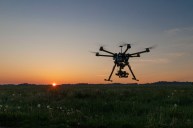A December Instagram post showing two people preparing to fly a drone in Death Valley National Park has outraged outdoors enthusiasts across the internet. The photos, posted to a popular feed about national park visitors, sparked heated exchanges in the comments section over the use of drones in national parks.
To a drone operator, the expansive stretches of the US's national parks may seem like the ideal place to film. To those of us who aren't drone operators—including wildlife—few things are more annoying than having a loud drone buzzing overhead while we're enjoying nature. As one Instagram user, ashley.dude.knits, commented on the post, "One of the most memorable aspects of my trip to Death Valley was how silent it was. No breeze, no bug sounds, nothing."
The National Park Service agrees: The launching, landing, and operation of "unmanned aircraft," including drones and model airplanes, is prohibited in national parks with very few exceptions. A policy memorandum by the National Park Service banned drones back in 2014, citing increased concerns about the safety of visitors, staff, and wildlife. Violation of the ban is considered a misdemeanor, with a maximum penalty of six months in jail and a $5,000 fine.
With good reason, it seems. As the NPS explains, "Small drones have crashed in geysers in Yellowstone National Park, attempted to land on the features of Mount Rushmore National Memorial, been lost over the edge of the Grand Canyon, and been stopped from flying in Prohibited Airspace over the Mall in Washington DC."
In addition, drones are banned in Wilderness Areas managed by federal agencies, such as National Forest and Bureau of Land Management (BLM). Drones may be allowed in non-Wilderness designated areas of federal and state land, but prohibitions vary depending on the state, land agency, and park system. If you intend to fly your drone on public land, make sure you read the laws regarding that parcel of land carefully.
While plenty of drone pilots safely and capably handle their unmanned aircraft, the increased accessibility of drones means they get into the hands of plenty of inexperienced pilots. Regardless of how expertly a drone is controlled, it poses a risk to people and wildlife; in 2015, a drone flew too close to a herd of bighorn sheep in Zion National Park, spooking the animals and separating several young sheep from the adults.
If you see someone flying a drone in a national park or other prohibited space, rather than posting photos of the people online, politely let them know they are breaking the rules and/or contact local park rangers to let them know. It's always best to assume ignorance or even positive intent; while popular areas of national parks are often signposted to let people know drones are prohibited, some people may not know the rules. The NPS also may fly its own drones—with approval from the directors of the region—for search and rescue operations, fire operations, and scientific study.
READ MORE: I've Been to 18 National Parks—These Are the Worst Mistakes I See Visitors Make Over and Over




